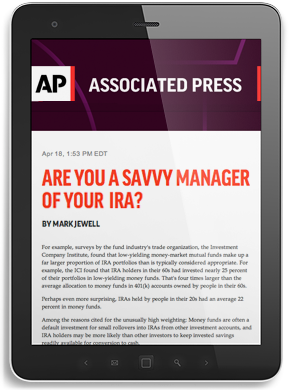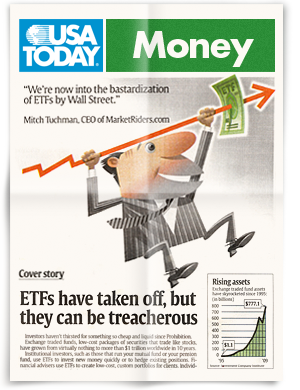Tools To Help Pick ETFs - Online Resources Can Also Help Investors Rebalance Their Holdings

Exchange-traded funds have become increasingly viable as core ingredients of a diversified portfolio. Originally pitched as low-cost alternatives to stock index funds, ETFs are now available for almost every asset class.
But with more than 800 ETFs on the market, choosing which funds to buy has become more difficult. And for a portfolio with a mix of funds, maintaining target asset allocations as the values of various holdings shift can get complicated.
Some online services from brokerage firms and others can help with both tasks, although the assistance typically comes at a cost. Here’s a sampling of what’s available from various providers:
The online brokerage firm Foliofn Investments Inc., founded in 1998 by Steven Wallman, a former commissioner of the Securities and Exchange Commission, aims to make it easy to create and manage portfolios of multiple securities. While the original focus was on individual stocks, the approach is an excellent fit for ETFs.
Users of the site invest in portfolios, or “folios,” comprising as many as 100 ETFs, stocks or other holdings.
You can create your own folios or pick from more than 100 suggestions. The site makes it easy to rebalance back to your original allocation targets and to stick with that allocation plan as you invest additional dollars or withdraw money from your account.
Say, for instance, you invest $10,000 in a six-ETF folio, including 40% in an ETF tracking the Standard & Poor’s 500-stock index. If you want to invest an additional $1,000, one click will spread your dollars among the six ETFs according to your target allocations, including $400 to that S&P 500 fund.
But maybe U.S. stocks have risen more than other holdings recently, so that S&P fund has grown to be larger than 40% of your portfolio. You could, with a single click, request to have your new contribution distributed so that it nudges your portfolio back toward your allocation targets, which would mean putting less than 40% of the new dollars into the S&P 500 fund.
The site also makes it easy to rebalance a folio back to its target mix by moving dollars from some holdings to others. Investors can get alerts to keep them on track.
Folio Investing offers its own predesigned folios of ETFs and some created by outside providers. For instance, the firm’s retirement-focused Target Date folios of ETFs come in 24 varieties—offering target retirement dates at five-year intervals as well as three levels of risk (conservative, moderate and aggressive) for each target date. The 7Twelve Life Stage folios designed by Brigham Young University professor Craig Israelsen each use 12 funds to give exposure to a total of seven broad asset classes.
Partners are vetted before their portfolios are featured, but Folio Investing offers no opinion on the offerings or their allocations, says Mr. Wallman.
ETF investors willing to let their trades be processed only at designated times during the day, starting at 11 a.m. and 2 p.m., pay $4 for each ETF bought or sold. Market orders executed at other times cost $10 each, and there’s a $15 quarterly fee if fewer than four trades are made.
Alternatively, users can pay $29 a month or $290 a year for unlimited trades processed during the two designated time periods.
MarketRiders
This site is designed to help investors create and manage ETF portfolios exclusively. MarketRiders, founded in 2008 by entrepreneur and investor Mitch Tuchman, isn’t a brokerage firm. Users execute trades through the online broker of their choice and then input the trades into the MarketRiders system; the site tracks the portfolio, updating prices daily, and sends email alerts for periodic rebalancing.
Users start by creating a portfolio. MarketRiders suggests portfolios using mostly funds from Vanguard Group and BlackRock Inc.’s iShares unit, with the allocation based on the user’s answers to questions about age, investment horizon and risk tolerance. For instance, a 40-year-old with a moderate risk tolerance and an investment horizon of more than 10 years was shown a suggested portfolio of 14 ETFs spanning several asset classes, including real estate and gold.
The company also offers a do-it-yourself option, which suggests asset-allocation levels and ETFs for each asset class but then gives users the opportunity to personalize the portfolio.
MarketRiders says that in a “normal” market, users are likely to get two to four rebalancing alerts a year. But you can adjust the settings so that a smaller or bigger change in portfolio values triggers those email notices.
The site charges $9.95 a month or $99.95 per year.
ING Direct ShareBuilder
This site, run by a unit of ING Group NV,
is geared to no-frills, buy-and-hold investors who want to add money to their portfolios at regular intervals. The PortfolioBuilder tool was among the easiest to set up of those reviewed here.
For scheduled investments in stocks, mutual funds and ETFs, ShareBuilder charges $4 per trade or $12 per month for six trades or $20 per month for 20 trades. Unscheduled trades are $9.95 each.
Need guidance on which ETFs to buy? ShareBuilder’s brief questionnaire places investors into one of five risk profiles, and account holders can get a suggested portfolio of no more than six ETFs from the iShares lineup. Portfolios can have as few as two ETFs.
Rebalancing isn’t automatic, nor is there an alert system.
E*Trade
E*Trade Financial Corp., like a number of other brokerage firms, will manage portfolios of ETFs for investors for a fee. But investors can also use the firm’s Online Advisor tool to get a recommended portfolio of ETFs at no charge. Trades are subject to commission charges starting at $9.99 for an ETF.
The Online Advisor tool involves answering a longer-than-usual investor survey—with questions about how much money you have, your risk tolerance, when you expect to draw down the money and what you are saving for. Visitors who aren’t registered on the site as customers are asked to supply their names and contact information in order to see the recommended portfolio.
E*Trade then responds with one of seven asset-allocation portfolios using as few as five ETFs, mostly iShares and Vanguard offerings as well as the SPDR S&P 500 fund.
The Online Advisor is tougher to navigate than other tools surveyed. For one thing, if the tool decides from your survey answers that you have a low risk tolerance, you have to redo the entire survey to see how its recommendations would differ for a moderate or high risk tolerance—and figuring out which answers would alter its assessment of your risk tolerance is a guessing game.
Also, while E*Trade says it sends out annual reminders for investors to check their allocations, the service doesn’t include an allocation alert if the portfolio gets out of whack between reminders.
TD Ameritrade
On this site from TD Ameritrade Holding Corp., which offers a range of services, click on the Planning & Retirement tab, then on Portfolio Guidance to see portfolio services.
The Self-Directed Amerivest option allows users to complete a questionnaire and see a suggested portfolio of ETFs based on one of five risk profiles. You can customize the portfolio by using some different ETFs from those that are recommended. Investors can choose to have their portfolios automatically rebalanced at regular intervals. They can also choose to have new investment dollars automatically directed to bring allocations back in line.
Target-date portfolios of ETFs are also available.
Investors using these two portfolio services pay no commissions for trades. Instead they pay fees starting at 0.75% of the amount invested up to $100,000 and dropping for higher amounts. A minimum investment of $25,000 is required.






